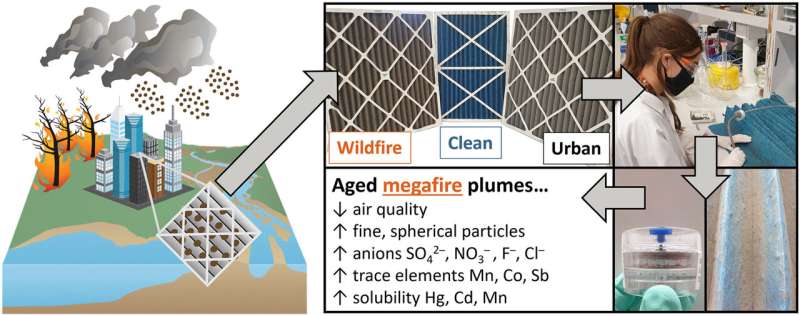This article has been reviewed according to Science X's editorial process and policies. Editors have highlighted the following attributes while ensuring the content's credibility:
fact-checked
peer-reviewed publication
trusted source
proofread
Office air conditioning can reduce the risk of harm from bushfire smoke, research shows

Air conditioning in our workplaces doesn't just cool the air—it can also help trap particles from bushfire smoke and reduce our exposure to potentially harmful elements like soluble mercury, sulfate and nitrate, new research shows.
Bushfire smoke can cause or exacerbate health conditions such as asthma, chronic obstructive pulmonary disease (COPD) and heart disease, and lead to an increased risk of hospitalization and death.
The study, published in the journal Environmental Pollution, was led by University of Technology Sydney (UTS) Ph.D. candidate in environmental science, Raissa Gill, a recipient of a UTS Research Excellence Scholarship, together with researchers from UTS and UNSW Sydney.
"The bushfires that raged across Australia during the 2019–2020 'Black Summer' produced an enormous amount of air pollution, with plumes of smoke traveling long distances and cloaking Sydney and surrounding areas," said Gill.
"We wanted to find out more about what was in the bushfire smoke we were breathing. By using commercial air conditioning filters, we were able to capture and analyze the chemical composition of particles that would otherwise have been inhaled," she said.
The researchers collected particulate matter from heating, ventilation, and air-conditioning (HVAC) filters in UTS Buildings 4 and 7 during the peak of the Black Summer bushfires as well as one year later as a reference point.
They found daily particulate matter concentrations were generally 2–3 times higher than normal, with hourly concentrations reaching up to 10.5 times the usual maximum. This exceeded the national standards on 19% of days across the four-month sampling window. The particles were also finer and contained a different mixture of toxic chemicals.
"Bushfire aerosols contained much smaller, rounder particles than urban aerosols, making them more likely to be inhaled into our lungs and to transfer toxic elements into our bloodstream," said co-author UTS Professor Martina Doblin.
"These particles also contained more soluble forms of mercury, as well as higher concentrations of sulfate, nitrate and fluoride ions and metals including manganese, cobalt, and antimony. Mercury is quite toxic even in low concentrations and can cause neurological problems and lung damage."
The study highlights the diverse chemical changes that severe bushfire events exert on the atmosphere. Understanding these changes is crucial for assessing the impact of bushfires and their potential consequences for human health and environmental quality.
"While air quality in Sydney is usually good by world standards, recent evidence has clearly shown that the handful of days that we get every year with high pollution loads from bushfires and dust storms lead to significant disease and death in the community," said co-author UTS Associate Professor Fraser Torpy.
"Studies that build an understanding of these high pollution events are critical in helping us determine what is causing these health crises and will lead to a better understanding of how we can protect the vulnerable members of the community," he said.
While HVAC systems are not designed specifically for bushfire smoke, research on indoor air quality in Canberra during the 2019-2020 fires showed that outdoor concentrations of fine particulate matter were up to 10 times higher than measured values indoors with air conditioning.
The current study shows the UTS HVAC filters were able to capture a significant portion of bushfire smoke, reducing exposure to toxic particles for staff and students working in these buildings. It also underscores the importance of considering higher-rated HVAC filters during fire seasons and maintaining and replacing the filters regularly.
"Australians face significant obstacles in achieving satisfactory air quality during major bushfire events. Many homes and older buildings rely on natural ventilation or have poor HVAC filtration efficiency and gaps that allow smoke to enter. These systems can also be costly and complicated to manage for effective protection during bushfires," Gill said.
"Given that severe bushfires are projected to increase with climate change, the role of bushfire-ready infrastructure in maintaining public health, as well as the need to reduce greenhouse gas emissions, is now more pressing than ever."
More information: Raissa L. Gill et al, Fine particle pollution during megafires contains potentially toxic elements, Environmental Pollution (2024). DOI: 10.1016/j.envpol.2024.123306




















